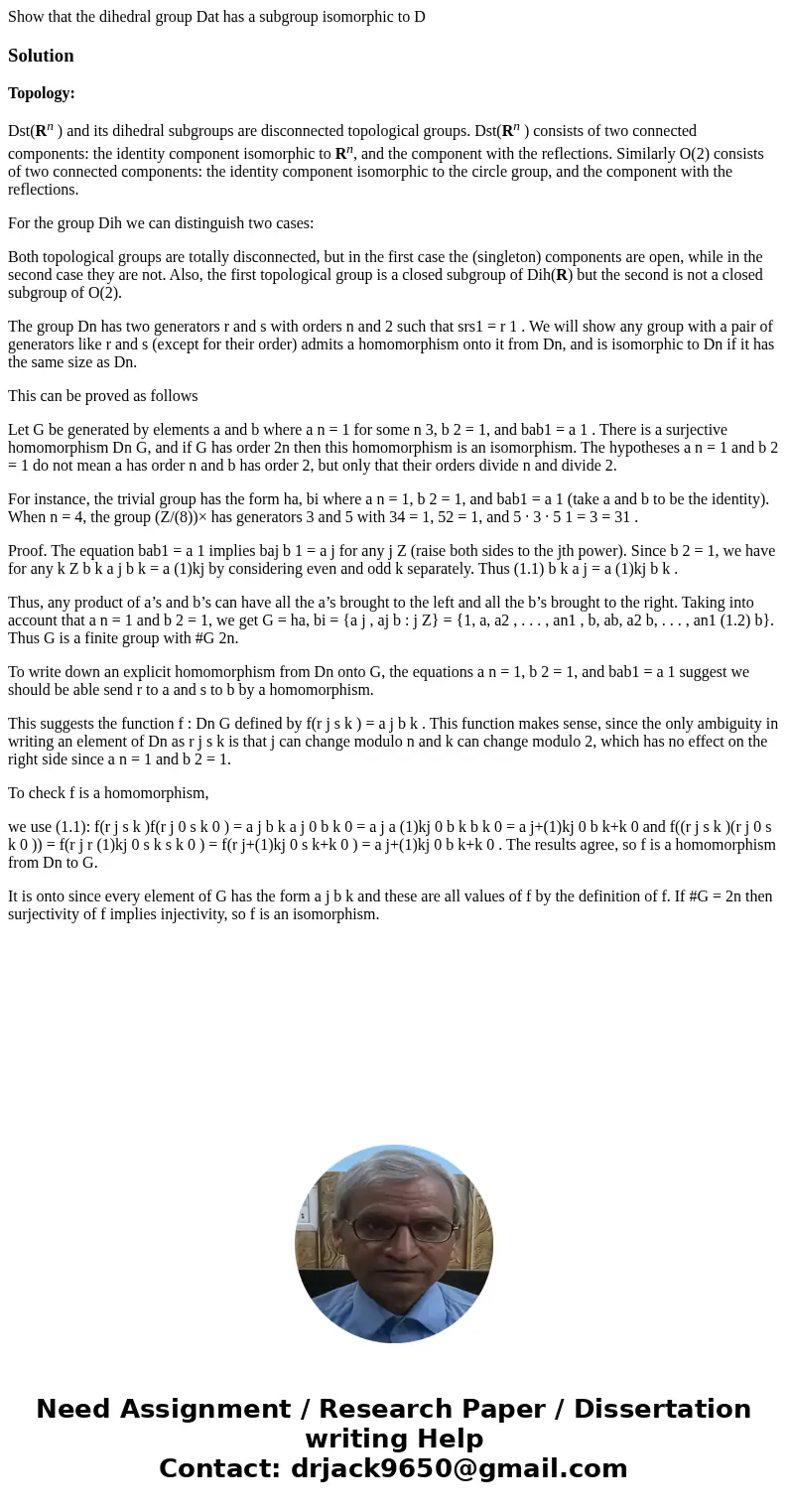Show that the dihedral group Dat has a subgroup isomorphic t
Solution
Topology:
Dst(Rn ) and its dihedral subgroups are disconnected topological groups. Dst(Rn ) consists of two connected components: the identity component isomorphic to Rn, and the component with the reflections. Similarly O(2) consists of two connected components: the identity component isomorphic to the circle group, and the component with the reflections.
For the group Dih we can distinguish two cases:
Both topological groups are totally disconnected, but in the first case the (singleton) components are open, while in the second case they are not. Also, the first topological group is a closed subgroup of Dih(R) but the second is not a closed subgroup of O(2).
The group Dn has two generators r and s with orders n and 2 such that srs1 = r 1 . We will show any group with a pair of generators like r and s (except for their order) admits a homomorphism onto it from Dn, and is isomorphic to Dn if it has the same size as Dn.
This can be proved as follows
Let G be generated by elements a and b where a n = 1 for some n 3, b 2 = 1, and bab1 = a 1 . There is a surjective homomorphism Dn G, and if G has order 2n then this homomorphism is an isomorphism. The hypotheses a n = 1 and b 2 = 1 do not mean a has order n and b has order 2, but only that their orders divide n and divide 2.
For instance, the trivial group has the form ha, bi where a n = 1, b 2 = 1, and bab1 = a 1 (take a and b to be the identity). When n = 4, the group (Z/(8))× has generators 3 and 5 with 34 = 1, 52 = 1, and 5 · 3 · 5 1 = 3 = 31 .
Proof. The equation bab1 = a 1 implies baj b 1 = a j for any j Z (raise both sides to the jth power). Since b 2 = 1, we have for any k Z b k a j b k = a (1)kj by considering even and odd k separately. Thus (1.1) b k a j = a (1)kj b k .
Thus, any product of a’s and b’s can have all the a’s brought to the left and all the b’s brought to the right. Taking into account that a n = 1 and b 2 = 1, we get G = ha, bi = {a j , aj b : j Z} = {1, a, a2 , . . . , an1 , b, ab, a2 b, . . . , an1 (1.2) b}. Thus G is a finite group with #G 2n.
To write down an explicit homomorphism from Dn onto G, the equations a n = 1, b 2 = 1, and bab1 = a 1 suggest we should be able send r to a and s to b by a homomorphism.
This suggests the function f : Dn G defined by f(r j s k ) = a j b k . This function makes sense, since the only ambiguity in writing an element of Dn as r j s k is that j can change modulo n and k can change modulo 2, which has no effect on the right side since a n = 1 and b 2 = 1.
To check f is a homomorphism,
we use (1.1): f(r j s k )f(r j 0 s k 0 ) = a j b k a j 0 b k 0 = a j a (1)kj 0 b k b k 0 = a j+(1)kj 0 b k+k 0 and f((r j s k )(r j 0 s k 0 )) = f(r j r (1)kj 0 s k s k 0 ) = f(r j+(1)kj 0 s k+k 0 ) = a j+(1)kj 0 b k+k 0 . The results agree, so f is a homomorphism from Dn to G.
It is onto since every element of G has the form a j b k and these are all values of f by the definition of f. If #G = 2n then surjectivity of f implies injectivity, so f is an isomorphism.

 Homework Sourse
Homework Sourse